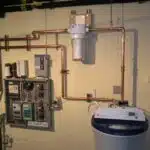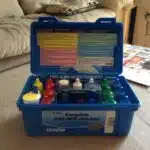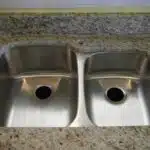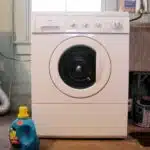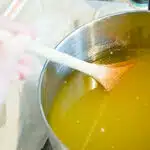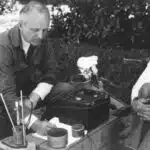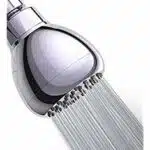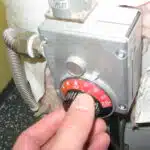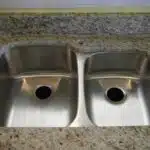As a hard water testing expert, I have encountered countless individuals who are unaware of the negative impacts of hard water on their daily lives. Hard water can cause a variety of issues, from dry skin and hair to decreased efficiency of household appliances. Thankfully, testing for hard water is a simple and straightforward process that can be completed with minimal effort and expense.
In this article, we will explore the various ways in which you can test for hard water in your home. We will discuss both DIY methods as well as professional testing options, providing you with the knowledge you need to make informed decisions about how best to tackle any hard water problems you may encounter. By understanding how to detect hard water, you can take the necessary steps to protect your health and comfort while also ensuring that your appliances remain in top condition for years to come.
What Is Hard Water?
Hard water is a type of water that contains high levels of dissolved minerals, primarily calcium and magnesium. It is important to understand the differences between hard and soft water since it can affect your daily activities using water. The causes of hard water are due to natural geological processes such as the presence of limestone or chalk deposits in underground aquifers.
The primary difference between hard and soft water lies in their mineral content. Hard water contains more calcium and magnesium ions compared to soft water which has lower concentrations of these minerals. Calcium and magnesium are important nutrients for humans, but when present in high amounts in drinking water, it can lead to several problems such as limescale build-up in pipes and appliances, making them less efficient over time.
In addition, hard water can also cause skin irritation, hair damage, and even interfere with soap’s ability to lather properly. This is because the minerals present in hard water react with soap to form insoluble compounds that do not dissolve easily in the washwater. As a result, clothes may become dingy or grayish over time. It is essential to test for hard water so that you can determine if you need to take necessary steps to soften it before using it for daily activities such as washing dishes or taking a shower.
Moving forward from understanding what hard water is and its causes, we will now explore common signs of hard water that you should look out for in your household or workplace.
Common Signs Of Hard Water
Hard water is a common problem in many households. It is caused by the presence of high levels of minerals, such as calcium and magnesium, in the water supply. Some common signs that you may have hard water include dry skin, dull hair, and soap scum buildup in your shower or bathtub.
One way to test for hard water is to look for white spots on your dishes after they have been washed. If you notice these spots, it may be an indication that you have hard water. Another way to test is to fill a clear container with water and add a few drops of dish soap. If the water becomes cloudy or produces little bubbles, it could be a sign of hard water.
If you do have hard water, there are several steps you can take to deal with the effects. For example, if you are struggling with hard water stains on your fixtures or surfaces, you can use vinegar or lemon juice to help dissolve them. Additionally, if you want to prevent hard water buildup in your pipes, consider investing in a water softener system or using special filters designed to remove minerals from the supply before they reach your home’s plumbing system. By taking these steps and being proactive about managing hard water issues, you can avoid many of the negative effects associated with this common household problem.
Transition: While it’s important to address the visible effects of hard water on our homes and appliances, it’s equally important to consider how it can impact our health over time. Let’s explore some of these potential health effects in more detail next.
Health Effects Of Hard Water
According to a recent study, approximately 85% of households in the United States have hard water. Hard water is a common problem that can cause numerous issues such as dry skin, dull hair, and stains on clothes. If you suspect that your home has hard water, it is important to test it to determine the level of hardness.
There are several ways to test for hard water. One of the easiest methods is using a test strip that changes color depending on the level of minerals in the water. Another method is using soap or detergent to see how well they lather in the water. If they do not create suds easily, it may indicate that there are too many minerals present. It is also possible to purchase a water testing kit that provides more detailed information about the hardness level and other contaminants present in the water.
Once you have determined that your home has hard water, it is important to take steps to address the issue. One solution is installing a water filtration or purification system in your home. These systems remove minerals and other contaminants from your water supply, providing cleaner and softer water for household use. By investing in a quality filtration system, you can protect your appliances and plumbing from damage caused by hard water while also improving the overall quality of your household’s drinking and bathing water.
The impact of hard water on household appliances can be significant over time if left untreated. The mineral buildup caused by hard water can lead to clogs and corrosion in pipes, reducing their lifespan and increasing repair costs. Household appliances such as dishwashers and washing machines can also be affected by hard water, leading to poor performance and shorter lifespans. By addressing hard water through proper testing and installation of a filtration or purification system, homeowners can protect their investments while also improving their daily lives with better quality household products like soft towels and brighter clothes after each wash cycle.
Impact Of Hard Water On Household Appliances
Hard water can lead to corrosion of household appliances, reducing their lifespan and efficiency. This can be caused by the build-up of dissolved minerals such as calcium and magnesium in the water. Limestone buildup is another common result of hard water, and can cause blockages and reduce water flow in pipes. In order to test for hard water, a titration test should be conducted to measure the amount of calcium and magnesium ions in the water.
Appliance Corrosion
Imagine waking up in the morning to a rusted and corroded coffee maker. The water that you have been using to make your coffee is hard water, which has been slowly damaging your appliance over time. Appliance corrosion is one of the most common issues caused by hard water. Hard water contains high levels of dissolved minerals such as calcium and magnesium that can wreak havoc on your appliances.
As a hard water testing expert, it is my duty to inform you about the impact of hard water on household appliances. Prevention methods are essential in minimizing or even eliminating appliance corrosion caused by hard water. One way to prevent corrosion is by installing a whole-house water softener system that removes the minerals in the water before it reaches your appliances. Another method is to use vinegar or lemon juice to clean your appliances regularly.
Appliance maintenance is also crucial in preventing appliance corrosion caused by hard water. Regular cleaning and descaling of appliances like coffee makers, dishwashers, and washing machines can go a long way in keeping them from corroding due to mineral buildup. By following these prevention methods and performing regular maintenance on your appliances, you can ensure that they last longer without any damage from hard water.
Lime Scale Buildup
As a hard water testing expert, it is my responsibility to inform you about the impact of hard water on household appliances. One of the most common problems caused by hard water is lime scale buildup. Lime scale is formed when minerals in hard water accumulate on surfaces, and it can cause significant damage to your appliances over time.
Removing lime scale is essential in preventing appliance corrosion caused by hard water. Prevention methods such as installing a whole-house water softener system or using vinegar or lemon juice to clean your appliances regularly can help prevent lime scale buildup. However, if lime scale has already accumulated, you may need to use more potent cleaning agents like specialized descaling agents to remove it.
Regular maintenance of your appliances is also crucial in preventing lime scale buildup. Frequent cleaning and descaling of appliances like coffee makers, dishwashers, and washing machines can go a long way in keeping them from corroding due to mineral buildup. By following these prevention methods and performing regular maintenance on your appliances, you can ensure that they last longer without any damage from hard water.
Diy Testing Methods
Hard water can cause various problems at home, including clogged pipes and faucets, dry skin, and dull clothes. To determine if your water is hard, you can conduct a DIY test using some readily available items from your kitchen.
Before starting the DIY testing process, it is essential to note that the accuracy of these methods may vary. Therefore, it is best to use alternative testing methods for better precision. Here are some DIY methods you can try at home:
- Soap Test: This method involves mixing soap flakes with water in a bottle and shaking it vigorously. If the mixture produces suds quickly and lasts long without disappearing, your water is likely soft. However, if there are no or few bubbles formed and disappear fast, then the water is hard.
- Vinegar Test: Another popular way of determining if your water is hard or not involves mixing distilled white vinegar with tap water in equal parts and observing any reaction. If there’s little or no reaction, then the water is soft; however, if there’s a noticeable fizzing sound or bubbles forming on top of the mixture after stirring it gently for about 15 seconds, then it’s hard.
- Water Hardness Strips: These strips are an alternative option that provides more accurate results than DIY methods. They come with color comparison charts that help determine the level of hardness present in your water sample accurately.
By following these simple steps mentioned above for DIY testing accuracy and alternative testing methods mentioned below, you can confirm whether your tap water has high levels of minerals or not before taking necessary measures to soften it. In the next section, we will discuss how to conduct a soap test to check for hard water at home without needing any additional tools or equipment.
Soap Test
Like a detective searching for clues, testing for hard water is a meticulous process that requires careful attention to detail. One effective way of doing this is through the soap test, which can help you determine whether your water supply contains high levels of minerals such as calcium and magnesium. This is crucial because hard water can cause damage to plumbing systems, appliances and even your skin.
To perform the soap test, begin by lathering up some soap in your hands using cold water. If the soap produces suds quickly and easily, then it’s likely that you have soft water. However, if the soap takes longer to lather and produces fewer suds that are difficult to rinse off, then you may have hard water. This is because the minerals present in hard water tend to react with soap and prevent it from forming suds.
If you find that your water is indeed hard, there are alternative methods you can use to test its hardness level. One such method involves using vinegar as a testing agent. Simply add a few drops of vinegar to a sample of your water supply and observe any changes in color or cloudiness. These changes can indicate the presence of calcium or magnesium ions in your water supply, which are responsible for making it hard. By using these methods, you can ensure that your household is protected against potential harm caused by hard water while also keeping your plumbing system in good condition.
Moving onto an alternative method for testing hard water – the vinegar test – this approach works by reacting with any minerals present in the water supply. Vinegar contains acetic acid which reacts with calcium carbonate (a common mineral found in hard water) producing carbon dioxide gas bubbles. To perform this test, add some vinegar to a sample of your tap or well-water supply and wait for any visible signs of reaction such as bubbling or cloudiness. In comparison to other testing methods, this technique provides an easy way to determine whether or not your household is experiencing hard water issues.
Vinegar Test
One common method of testing for hard water is the vinegar test. This involves filling a clear container with a sample of water and adding a small amount of vinegar. If the water turns cloudy or produces bubbles, it indicates the presence of minerals such as calcium and magnesium, which are responsible for hard water.
While the vinegar test is a simple and cost-effective way to test for hard water, it may not always provide accurate results. Alternative methods include using specialized test kits or sending a sample to a laboratory for analysis. It is important to consider factors such as the source of the water and any potential contamination that may affect the accuracy of the results.
To ensure accuracy when using the vinegar test, it is recommended to use distilled white vinegar and to perform multiple tests on different samples from various sources. Additionally, it is important to note that while hard water may have negative effects on appliances and plumbing systems over time, it is not necessarily harmful to human health.
4 items:
- When performing the vinegar test, use a clear container and add equal parts water and white distilled vinegar.
- The optimal temperature range for testing should be between 60-80°F (15-27°C).
- Consider factors such as the age and type of pipes in your home when interpreting test results.
- For more accurate results, consider alternative testing methods such as professional laboratory analysis or specialized test kits.
Transition: While the vinegar test can provide valuable insight into whether you have hard water in your home, there are other options available. One popular alternative method involves using water hardness test strips, which we will discuss in further detail in the following section.
Water Hardness Test Strips
Water hardness is often described as the amount of dissolved minerals in water. Hard water sources are typically composed of high levels of calcium and magnesium ions, which can cause complications in household appliances and furniture. Testing for hard water is essential to ensure that homeowners can maintain their plumbing systems and other equipment without the risk of damage.
One of the most straightforward methods for testing hard water is to use test strips. These strips come into contact with a sample of water, producing a visual color change that reflects the level of hardness. Different brands of strips will offer different levels of accuracy, so it’s essential to check reviews before purchasing.
Water hardness measurement methods range from simple tests like test strips to professional options like laboratory analysis. Professional testing options may be necessary if you’re unsure about the quality of your water or need more detailed information about its composition. These tests will typically involve a technician visiting your home to collect samples, which are then sent off for analysis at a lab. In some cases, they may use advanced techniques like ion chromatography or atomic absorption spectroscopy to get an accurate reading on the mineral content in your water.
Transition: While test strips provide an easy-to-use option for testing hard water, professional testing options offer more comprehensive results that can help you make informed decisions about your home’s plumbing system. Let’s take a closer look at some of these professional testing options and what they can tell us about our water quality.
Professional Testing Options
Water hardness is a common problem in households and can lead to various issues such as clogged pipes, soap scum, and dry skin. Testing for hard water is essential to determine the severity of the problem and find solutions to prevent further damage. While water hardness test strips are a convenient way to test for hard water at home, they may not provide accurate results. Therefore, it is recommended to seek professional testing options for accurate results.
Lab testing is the most reliable method of testing for hard water. In a laboratory setting, samples of water are analyzed using complex techniques that provide precise measurements of mineral content. The results obtained from lab testing can be used to determine the appropriate treatment plan for your specific needs. However, lab testing can be expensive and time-consuming.
Home testing kits are an affordable alternative to lab testing. These kits come with instructions on how to collect and test samples of water at home. Home testing kits use color-coded strips or drops that change color depending on the mineral content in the water sample. While these tests may not be as accurate as lab testing, they provide a general idea of whether your water is hard or soft.
- Lab testing provides precise measurements of mineral content.
- Home testing kits offer an affordable alternative to lab testing.
- Water hardness test strips may not provide accurate results.
- Accuracy in determining hardness levels helps select appropriate treatment plans.
- Hardness levels can have adverse effects on plumbing systems and personal hygiene.
With accurate results from hard water tests, you can take steps towards improving the quality of your household’s water supply. One solution commonly used for treating hard water is a water softener system. This system works by removing minerals such as calcium and magnesium through an ion exchange process, resulting in softer and cleaner-feeling water. Now that you know how to test for hard water using both professional and at-home methods, you can take action towards resolving any issues caused by high mineral content in your water supply.
Water Softener System
Water softener systems are a popular solution for hard water problems. With their ability to remove minerals like calcium and magnesium, they offer many benefits for homeowners. If you’re considering installing a water softener system in your home, it’s important to understand how to maintain it properly.
Water softener maintenance is essential for ensuring that your system works effectively over time. This includes regular cleaning of the resin tank, replenishing the salt supply, and checking for any leaks or malfunctions. By taking these steps, you can extend the lifespan of your water softener and prevent costly repairs down the line.
The benefits of using a water softener are numerous. Not only does it improve the taste and smell of your water, but it also helps protect your plumbing and appliances from mineral buildup. Additionally, softened water can result in softer skin and hair, making it an ideal choice for those with sensitive skin. Overall, investing in a water softener system is a smart choice for any homeowner looking to improve their home’s water quality.
Transition: Now that we’ve covered the benefits of using a water softener system, let’s explore another option for improving your home’s water quality – the reverse osmosis system.
Reverse Osmosis System
Water softener systems are highly effective in removing minerals that cause hard water. However, some homeowners prefer to use a reverse osmosis system instead. This system works by forcing water through a semi-permeable membrane that filters out impurities, including minerals that cause hard water.
One of the advantages of a reverse osmosis system is that it can remove a wider range of impurities than a water softener system. It can also improve the taste and odor of your drinking water. On the other hand, one disadvantage is that it produces more wastewater than other filtration methods. Additionally, it may not be as effective at removing some contaminants as other systems.
To maintain your reverse osmosis system, you should replace the membrane every two to three years and clean or replace the pre- and post-filters regularly. You should also avoid exposing the membrane to chlorine, which can damage it. It’s important to follow manufacturer instructions carefully to ensure optimal performance.
Moving forward, an ion exchange system is another option for treating hard water. This type of system uses resin beads to exchange ions with minerals in the water, effectively removing them from your supply. In the next section, we will explore this method further and discuss its advantages and disadvantages compared to both water softener and reverse osmosis systems.
Ion Exchange System
Imagine if your home’s plumbing system was a highway and the water flowing through it was traffic. Hard water would be like a traffic jam, clogging up the pipes and causing all sorts of problems. This is where ion exchange systems come in – they act like a toll booth, filtering out the hard minerals and allowing smooth flow through your pipes.
The benefits of ion exchange are numerous. They not only soften water by removing calcium and magnesium ions, but also improve its taste and odor by removing other contaminants such as chlorine, lead, and copper. Furthermore, softening water can save you money on cleaning products as well as prolonging the life of your appliances by reducing mineral buildup.
When it comes to choosing an ion exchange system for your home, there are several factors to consider such as size, capacity, regeneration frequency, and cost. Comparison of ion exchange systems should be done based on these factors to ensure that you select the right one for your needs. Some systems require more frequent regeneration than others while some may have a higher initial cost but lower maintenance costs in the long run. It’s important to do your research before making a decision to ensure that you get the most efficient system for your home.
Transition into subsequent section: Now that we’ve explored the benefits of ion exchange systems, let’s move on to choosing the right testing method for you.
Choosing The Right Testing Method For You
When it comes to testing for hard water, you have a choice between DIY or professional testing. DIY testing kits are generally more affordable and convenient, but may not be as accurate as professional methods. Professional tests can provide more detailed information about the hardness level and other factors that may affect your water quality.
Accuracy is important when it comes to testing for hard water, especially if you are trying to determine the best course of action for treating it. While DIY kits can give you a general idea of the hardness level, they may not be able to detect other contaminants that could be affecting your water quality. Professional testing methods can provide a more complete picture of your water quality, but they may come at a higher cost and require more time.
Ultimately, the choice between accuracy and convenience will depend on your individual needs and preferences. If you’re simply looking for a general idea of your water’s hardness level, a DIY kit may be sufficient. However, if you want more detailed information about your water quality or need to make decisions about treatment options, professional testing may be necessary. Whichever method you choose, understanding how to interpret your test results is key in determining the best course of action for ensuring clean and safe drinking water.
Transitioning into the subsequent section on interpreting test results: Understanding how to interpret your test results is crucial in determining what steps you need to take next in addressing any issues with hard water in your home.
How To Interpret Your Test Results
As we have discussed in the previous section, selecting the right testing method is essential to accurately test for hard water. Once you have conducted the test, it is crucial to interpret your results correctly. Interpreting your results will help you determine whether you need to take steps to prevent or treat hard water issues.
Accuracy of tests is a significant aspect when interpreting results. It is vital to ensure that you follow the instructions carefully and use the correct amount of reagents when conducting a test. Any deviation from these instructions can lead to inaccurate results, which can be misleading and result in inappropriate treatment measures.
Here are some key points to keep in mind when interpreting your hard water test results:
- The hardness level should be measured in grains per gallon (GPG).
- A hardness level of 1-3 GPG is considered soft water.
- A hardness level of 4-8 GPG is moderately hard.
- A hardness level above 8 GPG indicates very hard water.
By following these guidelines, you can accurately interpret your test results and make informed decisions about preventing or treating hard water issues in your home or business. In the next section, we will discuss prevention and treatment measures for hard water issues.
Preventing And Treating Hard Water Issues
Preventative measures are crucial in the fight against hard water issues. The first step is to understand the level of hardness in your water supply. This can easily be done by purchasing a test kit or contacting your local water supplier for information on the quality of their water. Once you have established the level of hardness, it is important to take steps to prevent further buildup.
One long-term solution is to install a water softener. Water softeners work by removing minerals such as calcium and magnesium from the water supply, effectively reducing its level of hardness. Other preventative measures include using vinegar or lemon juice to clean appliances that come into contact with hard water, such as coffee makers and kettles. Additionally, installing a whole-house filtration system can help remove impurities from your water supply.
Overall, preventing and treating hard water issues requires a combination of short-term solutions and long-term investments. By taking preventative measures such as regular cleaning and investing in a water softening system or filtration system, you can improve the quality of your home’s water supply and prolong the life of your appliances. Remember to regularly test your water supply to ensure that any new issues are identified early on and dealt with accordingly.
Conclusion
Hard water is a common problem in households across the world. It can have negative effects on both our health and our household appliances. Identifying whether or not you have hard water is the first step to preventing and treating any potential issues. There are various testing methods available, ranging from DIY methods to professional services. It is important to choose the right method for you to ensure accuracy in your results.
Once you have identified that you have hard water, it is crucial to take steps to prevent and treat any issues that may arise. This can include installing an ion exchange system or using specific products designed for hard water. Understanding how to prevent and treat hard water issues can save you time and money in the long run.
In conclusion, identifying whether or not you have hard water is essential for maintaining your health and protecting your household appliances. By choosing the right testing method, interpreting your results correctly, and taking preventative measures, you can avoid potential problems associated with hard water. As a hard water testing expert, I recommend regular testing and treatment to ensure optimal performance of your household appliances and overall well-being.
Image Credits
- “Running in water can be hard to keep track of the finish line.” by kennethkonica (featured)


